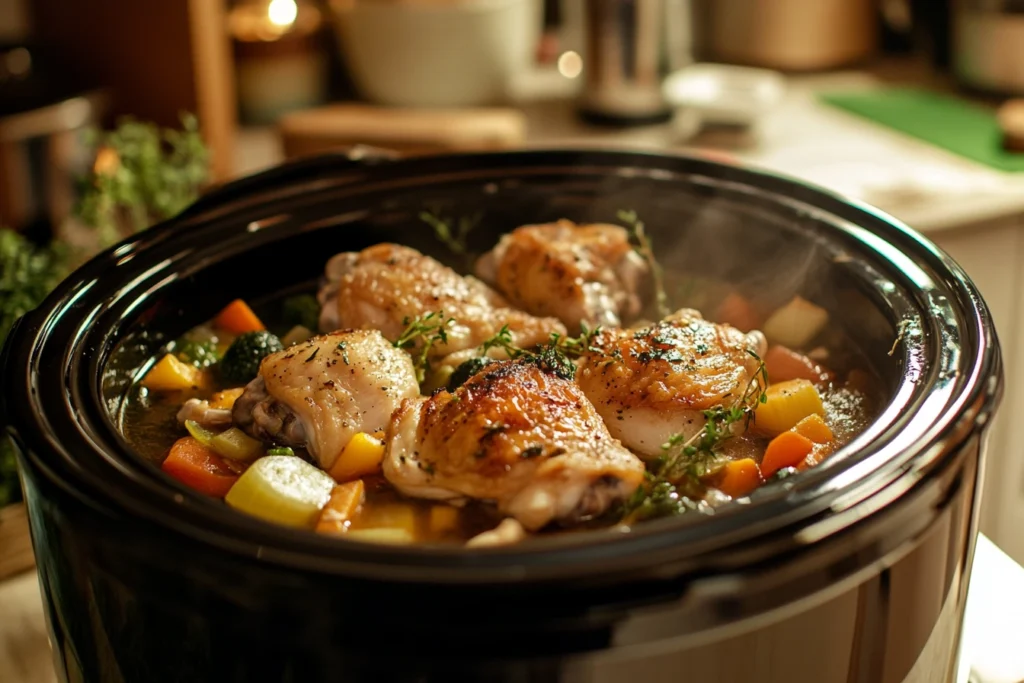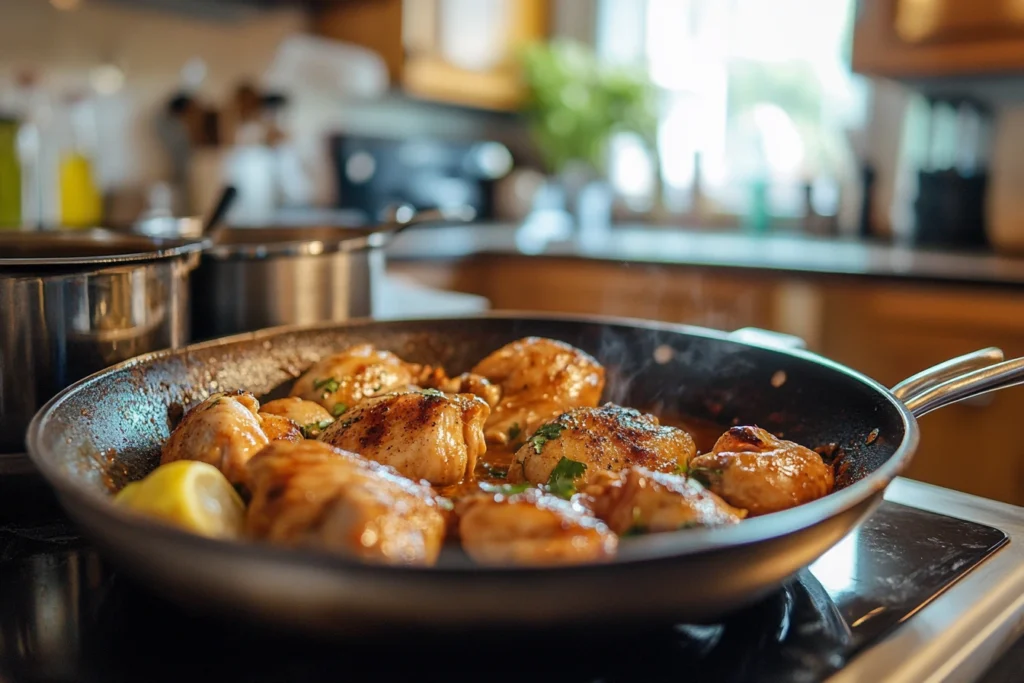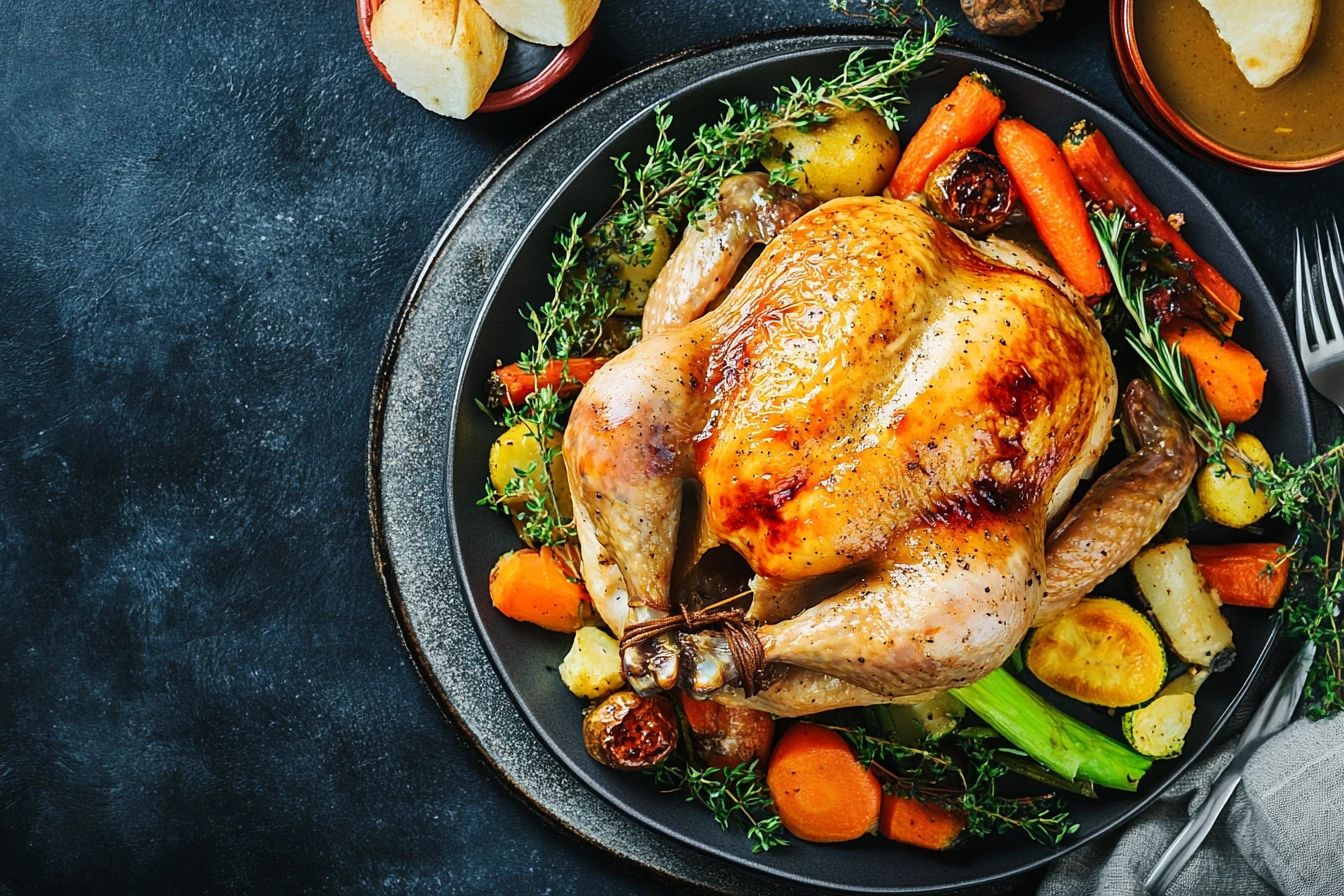Introduction
How to Avoid Rubbery Chicken in the Crockpot? Crockpot cooking is a game-changer for busy households, but it can sometimes yield unexpected results—like rubbery chicken. If you’ve ever opened your slow cooker to find a chewy, dry, or tough piece of chicken, you’re not alone. This article explores what causes this common issue and how you can avoid it. With insights into the science behind chicken texture, common mistakes, and practical solutions, you’ll master the art of cooking tender, flavorful chicken in your crockpot every time.
Introduction and Background
What Makes Chicken Rubbery in the Crockpot?
Rubbery chicken in the crockpot isn’t just frustrating—it’s puzzling. You’d think slow cooking would always make meat fall-off-the-bone tender, right? Well, not exactly. A rubbery texture often results from a mix of science and technique. To cook chicken perfectly, you need to strike the right balance between time, heat, and moisture.
The crockpot works by surrounding your food with low, consistent heat, allowing proteins to break down gradually. However, if things go wrong—like overcooking or insufficient liquid—the results can be less than appetizing. Too much heat can cause moisture loss, while cooking for too long can toughen the proteins.
Another overlooked factor is the type of chicken you’re using. Cuts like chicken breasts, though lean, tend to dry out easily compared to fattier options like thighs or drumsticks. Moreover, skipping steps like brining, marinating, or using enough liquid can amplify the problem.
So why is this topic so important? Besides avoiding a rubbery meal, understanding these nuances will ensure every chicken dish you prepare becomes a success story. Let’s delve deeper into the science of chicken texture to uncover the secrets to a tender, juicy outcome.
Understanding the Science Behind Chicken Texture
The Role of Collagen and Protein in Chicken Texture
To truly understand why chicken sometimes turns rubbery in the crockpot, you need to grasp what happens to the meat’s proteins and collagen during cooking. Collagen is a structural protein found in connective tissue. When heated slowly, it breaks down into gelatin, giving meat that melt-in-your-mouth texture. However, if you overdo it, the proteins denature, squeezing out moisture and leaving behind a dry, tough texture.
Crockpots excel at low, steady heat, which is ideal for breaking down collagen. But here’s the kicker: chicken, especially lean cuts like breasts, doesn’t have as much collagen as red meats. This means it can overcook faster in a slow cooker if you’re not careful. On the flip side, fattier cuts like thighs fare better because they retain more moisture and their higher fat content adds tenderness.
Why Moisture Retention Matters
Moisture retention is key to avoiding rubbery chicken. During cooking, water inside the meat evaporates, especially if you’re using a high setting or leaving the lid ajar. Unfortunately, once the moisture’s gone, you can’t bring it back. This is why it’s crucial to maintain adequate liquid levels in the crockpot—whether you’re using broth, water, or a sauce.
Additionally, the slow cooker’s lid plays a critical role in keeping the moisture locked in. Lifting the lid frequently allows heat and steam to escape, which can disrupt the slow, even cooking process. This isn’t just an annoyance—it directly affects the final texture of your chicken.
Common Mistakes When Cooking Chicken in a Crockpot
Overcooking: A Leading Cause of Rubbery Chicken
Overcooking is one of the top culprits when it comes to rubbery chicken. While the crockpot is designed for long cooking times, leaving chicken in for too long can backfire. Lean cuts like chicken breasts are especially vulnerable to this problem. Over time, the proteins tighten up, moisture evaporates, and what’s left is a tough, chewy texture.
Many recipes suggest cooking chicken on low for six to eight hours, but for chicken breasts, this is often too long. Thighs and drumsticks, thanks to their higher fat content, are more forgiving. To avoid overcooking, use a meat thermometer. Chicken is safe to eat when its internal temperature reaches 165°F (74°C). Pull it out as soon as it hits this mark to keep it juicy.
Insufficient Liquid in the Crockpot
Moisture plays a massive role in slow cooking, and not using enough liquid can lead to a dry, rubbery disaster. The crockpot relies on liquid—be it water, broth, or sauce—to create steam and maintain an even temperature. Without enough liquid, the chicken can dry out as it cooks, especially on high heat.
To ensure the right texture, aim for at least a cup of liquid for most crockpot recipes. If you’re using ingredients that naturally release moisture, like vegetables, you can adjust accordingly. Adding flavorful liquids, such as chicken stock or tomato sauce, not only prevents dryness but also enhances the overall taste of your dish.
Choosing the Wrong Cut of Chicken
The cut of chicken you choose matters more than you might think. Lean, boneless chicken breasts are a popular choice but are prone to drying out due to their low fat content. On the other hand, cuts like thighs, drumsticks, or even whole chicken retain more moisture and stand up better to long cooking times.
If you’re set on using chicken breasts, consider adding a layer of protection by brining them beforehand. This simple process of soaking the chicken in a saltwater solution helps it retain moisture during cooking. For dishes like soups or stews, bone-in cuts provide added flavor and tenderness, making them a superior choice for crockpot meals.
Best Practices for Avoiding Rubbery Chicken
Ideal Cooking Times for Chicken in a Crockpot
Timing is crucial when it comes to slow cooking. Chicken, particularly the lean breast cuts, can easily turn from tender to tough if left in the crockpot too long. Aiming for the right cooking time is crucial to avoid the dreaded rubbery texture.
For boneless chicken breasts, cook on low for 2.5 to 3.5 hours or on high for 1.5 to 2.5 hours. Bone-in thighs or drumsticks, thanks to their higher fat content, can handle longer cooking times—around 4 to 6 hours on low or 3 to 4 hours on high. Using a meat thermometer is your best bet. As soon as the internal temperature hits 165°F (74°C), your chicken is ready to come out.
It’s also worth noting that crockpot models vary. Some cook hotter than others, even on the same setting. Adjust your times if you’re working with a particularly high-powered slow cooker.
Maintaining Proper Liquid Ratios
The amount of liquid you use in your crockpot is one of the most important factors in cooking tender chicken. Too little, and you risk drying out your meat; too much, and your dish could end up watery. So, what’s the sweet spot?
As a general rule, use at least one cup of liquid for most crockpot recipes. This creates enough steam to keep the chicken moist while allowing it to absorb flavors from the surrounding liquid. Whether you’re using broth, water, or a sauce, ensure the chicken is at least partially submerged. For extra flavor, experiment with liquids like chicken stock, coconut milk, or tomato puree.
Layering ingredients is another handy trick. Place vegetables like carrots, onions, and celery beneath the chicken to create a natural buffer, helping the meat stay juicy and flavorful.
Pre-Cooking Preparations
Proper preparation can transform your crockpot chicken from rubbery to succulent. A few extra steps before cooking go a long way in ensuring the best results.
- Brining: Soaking your chicken in a simple saltwater solution for 30 minutes to an hour helps retain moisture. Add aromatics like garlic or herbs for an extra flavor boost.
- Marinating: A marinade with acid, like lemon juice or yogurt, helps tenderize the chicken. Allow it to rest for at least 2 hours or overnight for the best results.
- Seasoning: Don’t skimp on seasoning! A well-seasoned chicken absorbs flavors better and delivers a tastier meal.
By preparing your chicken thoughtfully, you create a strong foundation for a tender and flavorful dish.
Crockpot Features That Influence Cooking Results
Variations Between Crockpot Models
Not all crockpots are created equal, and the specific model you use can significantly affect how your chicken turns out. Differences in wattage, size, and even the material of the crockpot can influence cooking times and results.
Higher-wattage crockpots tend to cook faster, even on the low setting, which might lead to overcooked, rubbery chicken if you don’t adjust the cooking time. Similarly, larger crockpots may require more liquid since the increased surface area allows for more evaporation. If your crockpot is too big for the amount of chicken you’re cooking, the heat distribution might be uneven, leaving some parts overcooked and others underdone.
Opting for a programmable model can help you take the guesswork out of cooking. Features like timers, keep-warm settings, and temperature controls ensure your chicken doesn’t sit in the heat longer than necessary. When in doubt, consult the user manual for your specific model to understand its quirks.

Lid Management: To Peek or Not to Peek
We’ve all been tempted to lift the lid and take a peek, especially when the delicious aroma fills the kitchen. But opening the lid during cooking is one of the most common mistakes—and it directly impacts the texture of your chicken.
Every time you lift the lid, steam escapes, and the temperature inside the crockpot drops significantly. This interrupts the cooking process, making the chicken cook unevenly and lose moisture. While it might not seem like a big deal, even a few degrees of temperature loss can add 20 to 30 minutes to your cooking time.
The best practice is to leave the lid on until your chicken is almost done. If you must check for doneness, do it as quickly as possible and avoid lifting the lid multiple times. A transparent lid is a helpful feature that lets you monitor progress without releasing steam.
Recipes and Tips for Perfect Crockpot Chicken
Tried-and-Tested Crockpot Recipes for Tender Chicken
Perfect crockpot chicken starts with the right recipe. Below are a few options tailored for juicy, tender chicken, whether you’re cooking for a family dinner or meal prepping for the week.
- Herbed Chicken Thighs with Vegetables:
Combine chicken thighs, carrots, potatoes, onions, and garlic in the crockpot. Add chicken broth, fresh rosemary, thyme, and a squeeze of lemon juice. Cook on low for 6 hours. The result? A hearty, flavorful meal that’s anything but rubbery. - Slow-Cooker Chicken Tacos:
Place boneless, skinless chicken breasts in the crockpot with salsa, taco seasoning, and a splash of chicken broth. Cook on low for 4 hours, then shred the chicken for tacos, burritos, or rice bowls. The salsa keeps the chicken moist and packed with flavor. - Coconut Curry Chicken:
Mix chicken thighs with coconut milk, curry powder, garlic, ginger, and diced tomatoes. Cook on low for 5 hours and serve over rice or with naan bread. The fat content in the coconut milk helps prevent dryness, ensuring tender results.
These recipes are designed with moisture retention and optimal cooking times in mind, so you’ll never have to worry about rubbery chicken again.

Pro Tips from Chefs
Even the most basic crockpot recipe can benefit from professional techniques. Here are some expert tips to elevate your slow-cooked chicken game:
- Sear the Chicken First: While not always necessary, browning the chicken in a skillet before adding it to the crockpot enhances flavor and locks in juices. This step is particularly useful for recipes where you want a rich, caramelized taste.
- Layer Ingredients Strategically: Place heartier vegetables like carrots or potatoes at the bottom of the crockpot, with the chicken on top. This ensures even cooking and prevents the chicken from sitting directly in the liquid, which can lead to sogginess.
- Use Aromatics Generously: Herbs, garlic, onions, and spices can infuse the chicken with incredible flavor. Add them early in the cooking process so the flavors have time to meld.
- Finish with Fresh Ingredients: For a burst of freshness, stir in ingredients like chopped parsley, cilantro, or a squeeze of lemon juice right before serving.
By following these recipes and tips, you’ll master the art of slow-cooking chicken that’s tender, flavorful, and perfectly cooked every time.
Frequently Asked Questions
Why does chicken become rubbery in a crockpot?
Chicken becomes rubbery in a crockpot primarily due to overcooking and moisture loss. When lean cuts like chicken breasts are cooked for too long or at too high a temperature, the proteins tighten and expel their moisture, resulting in a chewy texture. Using sufficient liquid, the right cooking time, and fattier cuts like thighs can help avoid this problem.
How do you fix rubbery chicken after cooking?
While it’s difficult to fully reverse the rubbery texture, you can salvage your dish by shredding the chicken and adding it to a moist recipe, such as soups, casseroles, or sauces. Tossing the chicken in a flavorful sauce or gravy can also help reintroduce moisture and mask any toughness.
What is the best cut of chicken for crockpot cooking?
Fattier cuts like chicken thighs and drumsticks are ideal for crockpot cooking because they retain moisture better than lean cuts like breasts. Bone-in cuts also provide extra flavor and tend to stay tender during the long cooking process.
Can I cook frozen chicken in a crockpot without it becoming rubbery?
Cooking frozen chicken in a crockpot isn’t recommended by food safety guidelines, as it may not reach a safe temperature quickly enough. However, if you choose to do so, use sufficient liquid, and opt for a high setting to avoid prolonged cooking times. To ensure safety and texture, thaw the chicken beforehand.
Does cooking chicken on low or high heat make a difference?
Yes, the heat setting greatly impacts the final texture of the chicken. Cooking on low heat for the recommended time ensures the chicken stays moist and tender, while high heat can increase the risk of overcooking and drying out the meat.
Are there alternatives to using chicken in a crockpot?
Absolutely! While chicken is a popular choice, you can also use the crockpot to cook beef, pork, lamb, or even vegetarian proteins like tofu and lentils. These options often fare well in slow cooking and provide delicious alternatives for your meals.
Conclusion
Cooking chicken in a crockpot can be a simple, hands-off way to prepare delicious meals, but avoiding common pitfalls is key to achieving tender, juicy results every time. Understanding the science behind chicken texture, managing cooking times, using proper liquid ratios, and selecting the right cuts of chicken are all essential steps in preventing the dreaded rubbery chicken.
With tips like brining, layering ingredients, and leveraging the unique features of your crockpot, you can transform your chicken dishes into flavorful, mouthwatering creations. Armed with tried-and-true recipes and expert insights, you’re now equipped to tackle any slow-cooked chicken recipe with confidence.
Remember, every slow cooker and recipe is unique, so don’t hesitate to experiment. Whether you’re preparing chicken for tacos, hearty stews, or a comforting family dinner, these strategies will ensure you consistently achieve tender and flavorful results. Happy slow cooking!

